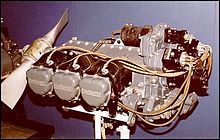
Back Platsessilinder Afrikaans Boksermotor-6 Danish Motor plano de seis cilindros Spanish מנוע שטוח 6 HE Motore a sei cilindri contrapposti Italian 水平対向6気筒 Japanese 6기통 수평 엔진 Korean Motor boxer de seis cilindros Portuguese 水平對臥六缸引擎 Chinese

A flat-six engine, also known as a horizontally opposed-six, is a six-cylinder piston engine with three cylinders on each side of a central crankshaft. The most common type of flat-six engine is the boxer-six engine, where each pair of opposed cylinders moves inwards and outwards at the same time. An alternative configuration for flat engines is a 180-degree V engine, where both cylinders move to the right then the left at the same time.
The advantages of the flat-six layout are good engine balance (for reduced vibration), a low center of gravity, short length (compared with an inline-six engine) and being well suited to air-cooling. The disadvantages are a large width (which can limit the maximum steering angle when used in a front-engined car), a large intake manifold being required when a central carburetor is used, and duplication of the inlet and outlet connections for water-cooled engines.[1]
The first production flat-six engine was in the 1904 Wilson-Pilcher 18/24 HP car. The most notable use of flat-six engines is the Porsche 911 sports car, which has used flat-six engines continuously since 1963. Several other car manufacturers, including Subaru, have produced flat-six engines at times. Flat-six engines have also occasionally been used in motorcycles, and commonly in general aviation aircraft, along with the flat-four engine.
- ^ Nunney, M J (2007). Light and Heavy Vehicle Technology. Butterworth-Heinemann. p. 13. ISBN 978-0-7506-8037-0. Retrieved 24 September 2019.